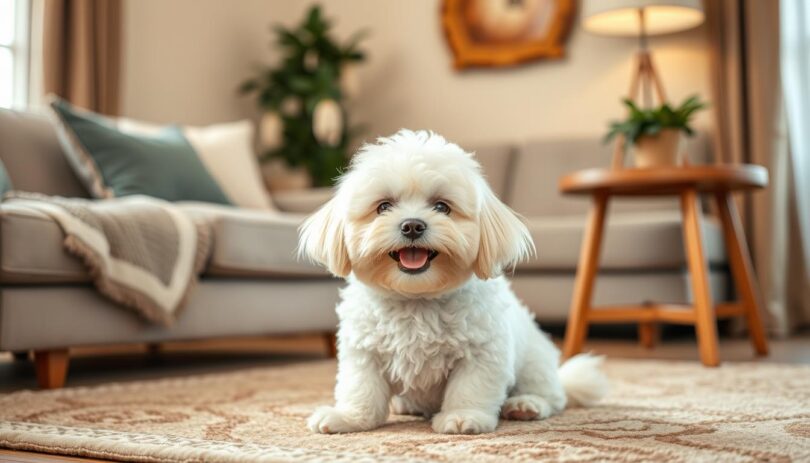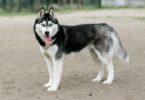Imagine a dog breed that merges sharp intelligence with endless cheerfulness. This isn’t a fantasy—it’s the reality of a designer hybrid gaining traction across American households. By blending the Toy Poodle’s problem-solving skills and the Bichon Frise’s joyful spirit, this crossbreed offers something truly special for modern pet owners.
Originating in Australia during the 1990s, this small companion weighs 6–17 pounds and stands 9–14 inches tall. Its curly, low-shedding coat makes it ideal for allergy sufferers, though weekly brushing remains essential. With a lifespan of 12–15 years, these dogs thrive in apartments and adapt effortlessly to families or singles.
Why does this mix stand out? Unlike many hybrids, it inherits the best qualities from both parents: the Poodle’s trainability and the Bichon’s affectionate nature. Early socialization helps channel their energy into positive behaviors, while regular grooming keeps their plush fur mat-free. Whether called a Bichpoo or Teddy Bear, their playful personality shines through.
This guide explores how these compact companions became America’s favorite hypoallergenic pets. You’ll discover their history, care needs, and why their adaptable temperament makes them perfect for urban living. Ready to meet the ultimate family-friendly hybrid?
Understanding the Poochon: Origins and History
Australian breeders in the 1990s set out to combine two beloved companion breeds into one ideal family pet. Their goal? To merge the Poodle’s sharp mind and hypoallergenic coat with the Bichon Frise’s cheerful personality. This intentional pairing created a designer dog breed tailored for urban living and allergy-prone owners.
The Beginnings of a Designer Breed
Breeders focused on health and temperament when developing this hybrid. By mixing first-generation (F1) Poodles with Bichons, they reduced genetic issues common in purebreds. Early adopters praised the crossbreed’s adaptability, sparking demand across Australia and later in the UK and US.
Merging the Poodle and Bichon Frise Legacies
The Poodle brought water-retrieving skills and problem-solving intelligence from its German roots. Meanwhile, the Mediterranean-bred Bichon contributed its royal French companion heritage. Together, these parent breeds created a social, low-shedding dog perfect for modern households.
Today’s standards prioritize the mix’s friendly nature and curly coat. From F1B generations (backcrossed with Poodles) to multi-generational lines, breeders continue refining this popular hybrid’s traits.
Unique Physical Traits and Appearance
Compact yet sturdy, this hybrid combines practicality with charm in its physical design. Measuring 9–15 inches tall and weighing 6–18 pounds, these dogs balance portability with durability. Their rectangular frame features a proportional build, making them agile companions for city dwellers.
Size, Shape, and Build
The breed’s structure leans toward slightly rectangular proportions, with balanced weight distribution across its muscular frame. This shape allows effortless movement while maintaining a toy-like appeal. Thick fur often disguises their athletic build, but regular grooming reveals well-defined contours ideal for active households.
Coat Colors and Textures
Curly or wavy coats dominate, ranging from plush teddy-bear textures to looser waves. Common colors include snow-white, creamy beige, and warm apricot, though silver or chocolate hues occasionally appear. The hypoallergenic fur traps dander but requires weekly brushing to prevent tangles.
Expressive round eyes and velvety folded ears frame the face, demanding regular cleaning to prevent infections. These features, combined with their manageable size, make the breed particularly suited for apartment living. Recognizing authentic traits helps owners distinguish this hybrid from similar small dogs during adoption.
Exploring the Poochon Temperament and Personality
What defines a dog’s true charm beyond its looks? For this hybrid breed, the answer lies in their heartwarming temperament. These dogs radiate affection while balancing playfulness with intelligence—a blend that makes them exceptional companions for diverse households.
Affectionate and Loyal Disposition
Known for forming tight bonds, these hybrids thrive on human interaction. They’ll follow you from room to room, eager to participate in daily activities. This loyalty stems from their Bichon Frise lineage, which contributes to their people-oriented nature.
Families appreciate their gentle patience with children. However, their devotion can lead to separation anxiety if left alone too often. Early exposure to varied environments helps them stay confident when meeting new people or pets.
Energy Levels and Playful Behavior
Morning zoomies and afternoon fetch sessions showcase their lively spirit. Their Poodle ancestry shines through in problem-solving games, where they quickly learn tricks for treats. Structured playtime channels this energy constructively.
Consistent training using praise-based methods works best. A 10-minute training session after walks keeps their focus sharp. Puzzle toys also help manage excitement during downtime, preventing destructive habits.
By blending structured routines with heartfelt interaction, owners nurture a well-adjusted companion. This approach taps into their innate intelligence while honoring their need for social connection.
Daily Activity and Exercise Needs for Poochons
Maintaining an active lifestyle isn’t just for humans—it’s a cornerstone of canine well-being. These spirited hybrids thrive on 30–40 minutes of daily activity split between physical exercise and mental challenges. Structured routines prevent boredom while supporting joint health and cognitive sharpness.
Balancing Movement and Mental Engagement
Two 15-minute walks spaced throughout the day work wonders for small breeds. Combine leash training with sniffing breaks to stimulate their curious minds. Indoor fetch sessions or interactive puzzle toys offer rainy-day solutions for apartment dwellers.
Morning agility drills and afternoon scent games keep their intelligence engaged. Owners report calmer behavior when dedicating time to varied activities like hide-and-seek or obedience drills. Consistent schedules help busy households allocate specific hours for play without disruption.
Over-exercising puppies under six months risks joint strain—short, frequent sessions are safer. Adults benefit from 45-minute routines mixing walks, training, and chew-toy exploration. This balanced approach reduces destructive chewing while promoting longevity through sustained fitness.
Grooming and Coat Maintenance Essentials
What separates a well-groomed companion from a tangled mess? Consistent care keeps these hybrids looking sharp while supporting their skin health. Their signature curly coat demands attention, but the effort pays off in reduced allergens and a polished appearance.
Brushing, Trimming, and Bathing Practices
Start with daily 5-minute brushing using a slicker brush. This prevents mats in tight curls while distributing natural oils. Professional groomers recommend trims every 4-6 weeks to maintain shape and prevent eye-obscuring bangs.
Bathe every 3-4 weeks with oatmeal-based shampoo. Always brush before baths to avoid tightening existing knots. Dry thoroughly with a low-heat blow dryer, combing as you go for smooth results.
Managing Hypoallergenic and Low-Shedding Coats
Weekly ear inspections prevent infections. Use vet-approved wipes to remove debris from folded ear flaps. Trim nails monthly and brush teeth 3x weekly – these steps complete the grooming routine.
New owners should pair sessions with high-value treats. Start with short brushing periods, gradually increasing time. Many groomers suggest Tuesday/Thursday schedules to build consistency without overwhelming pets or people.
This structured approach keeps coats allergy-friendly and skin healthy. Regular care stops minor issues from becoming costly vet visits while strengthening the bond between owner and companion.
Nutrition and Feeding Guidelines for Your Poochon
What fuels a dog’s wagging tail and bright eyes? The answer lies in smart nutrition choices. A balanced diet directly impacts energy levels, coat shine, and long-term health for small breeds like this hybrid. Tailoring meals to their size and activity prevents weight issues while supporting their playful nature.
Portion Sizes and Meal Frequency
Puppies need three daily meals of ¼–⅓ cup high-protein kibble until six months old. Adults thrive on ½–1 cup split into two portions. Active dogs may require 10% more calories, while seniors often need fewer. Always check food labels for AAFCO compliance and avoid fillers like corn or soy.
Use a measuring cup for accuracy and adjust portions monthly. Feel your dog’s ribs—if they’re hard to locate, reduce food by 10%. Treats shouldn’t exceed 10% of daily calories. Try frozen blueberries or carrot sticks for low-calorie rewards.
Quality matters: look for omega-3 fatty acids to boost coat health and probiotics for digestion. Rotate proteins like chicken, salmon, or lamb to prevent allergies. Consult your vet if switching diets or noticing sudden weight changes. A consistent feeding schedule prevents begging and supports metabolism.
Health and Wellness: Common Issues and Preventative Care
A dog’s vitality hinges on proactive care and early detection of potential concerns. While generally healthy, this hybrid may inherit conditions like patellar luxation (slipped kneecaps) or progressive retinal atrophy. Watch for limping, excessive eye-rubbing, or sudden clumsiness—these could signal underlying health problems.
Recognizing Signs of Health Problems
Skin irritation and frequent scratching often point to allergies, common in small breeds. Endocrine disorders like Cushing’s disease may show as increased thirst or hair loss. Monthly home checks help spot issues early: examine ears for redness, gums for discoloration, and weight fluctuations using a body condition chart.
Veterinary Checkups and Preventative Treatment
Schedule bi-annual vet visits for dogs under seven, increasing to quarterly for seniors. Core vaccines and parasite preventatives form the first defense against preventable diseases. Dental cleanings every 6-12 months combat gum disease, which affects 80% of small breeds by age three according to veterinary studies.
Balanced nutrition and daily exercise reduce obesity risks while supporting joint health. Combine these habits with consistent grooming to prevent skin infections. Early intervention often improves outcomes—80% of patellar luxation cases managed before age two require less invasive treatment.
Owners who prioritize routine care and prompt symptom reporting give their companions the best chance at reaching their 12-15 year lifespan potential. Book that wellness exam today—your vigilance shapes their tomorrow.
Training Tips: Obedience, Socialization, and Behavioral Guidance
Building a strong bond with your furry companion starts with smart training strategies. These intelligent hybrids respond best to routines that combine structure with fun. Early lessons lay the foundation for lifelong good habits while strengthening your relationship.
Starting Early with Positive Reinforcement
Begin training at 8-10 weeks using treats and praise. Teach “sit” by holding a reward above their nose, moving it backward until their bottom touches the floor. Reward immediately. Keep sessions under 10 minutes—short bursts prevent boredom.
Socialization matters just as much as commands. Introduce new people, sounds, and surfaces gradually. Pair these experiences with playtime or interactive puzzle toys to build positive associations. Certified trainers recommend exposing puppies to 100 different stimuli by 16 weeks.
Managing Vocal and Separation Anxiety
Excessive barking often stems from boredom or stress. Redirect attention with a “quiet” command followed by a treat when they pause. For separation anxiety, practice leaving for 5-minute intervals, gradually increasing time apart. Leave a worn shirt with your scent in their crate.
Desensitization works wonders. Record doorbell sounds at low volume during meals, increasing volume over days. Reward calm behavior. Canine behaviorists suggest teaching “place” or “mat” commands to create safe zones during stressful situations.
Consistency turns challenges into triumphs. Celebrate small wins—every mastered skill reduces future behavioral issues. Remember: training should feel like play, not work. Your enthusiasm fuels their progress.
Poochon in Everyday Family Life: Compatibility with Kids and Other Pets
The true test of a companion breed lies in its ability to blend into diverse family dynamics. These hybrids excel at adapting to homes with children, seniors, or multiple pets through their patient temperament and social intelligence. Their compact size and gentle nature make them particularly suited for families seeking a low-conflict companion.
Early socialization shapes their interactions with kids and animals. Introduce puppies to varied sounds, gentle handling, and supervised playdates during their first four months. This builds confidence around toddlers’ unpredictable movements and other pets’ boundaries.
Integrating Into Multi-Pet Households
Successful introductions require gradual steps. For homes with cats, let both animals sniff each other’s bedding first. With dogs, use neutral outdoor spaces for initial meetings. Owners should monitor body language—relaxed tails and soft eyes signal acceptance.
Consistent routines prevent jealousy in busy households. Feed pets separately to avoid competition, and schedule one-on-one playtime daily. These hybrids thrive when given clear roles, like participating in children’s homework sessions or joining morning walks with other dogs.
While their affectionate nature fosters strong bonds, their small stature demands supervision during play. Teach kids proper handling techniques, like supporting the chest and hindquarters. Families with older children often find this breed’s energy levels align well with active preteens.
Weekly family training sessions reinforce household rules. Practice commands like “leave it” around pet birds or guinea pigs. This collaborative approach strengthens relationships while maintaining harmony across species.
Embracing the Journey with Your Poochon
Welcoming a furry companion into your home means committing to a shared adventure. This hybrid’s journey—from curious puppy to devoted adult—reflects the care you invest. Their legacy as a Poodle-Bichon mix shines through in every wagging tail and clever trick.
Responsible pet parenting starts with understanding their needs. Regular grooming sessions, balanced meals, and vet checkups lay the foundation for a healthy life. Early socialization shapes their friendly nature, while consistent training turns energetic puppies into well-mannered companions.
Celebrate the small victories: mastering a new command, acing a vet visit, or simply enjoying quiet cuddles. These moments strengthen your bond and honor their dual heritage—the Poodle’s sharp mind paired with the Bichon’s joyful spirit.
Every stage brings rewards. Puppies teach patience, adults offer steadfast loyalty, and seniors remind us to cherish time. Approach care with curiosity and compassion—your efforts nurture a relationship that enriches both lives for years to come.
FAQ
What makes this designer breed suitable for allergy sufferers?
Their hypoallergenic, low-shedding coat inherited from Poodle and Bichon Frise parents minimizes allergic reactions. Regular grooming maintains coat health and reduces dander.
How much daily activity does a Poodle-Bichon mix require?
These dogs thrive with 30-45 minutes of exercise through walks and play. Mental stimulation with puzzle toys prevents boredom-related behaviors.
Are these hybrids good companions for families with young children?
Yes, their gentle temperament and playful nature make them excellent family pets. Supervision during interactions teaches kids proper handling.










Leave a Comment